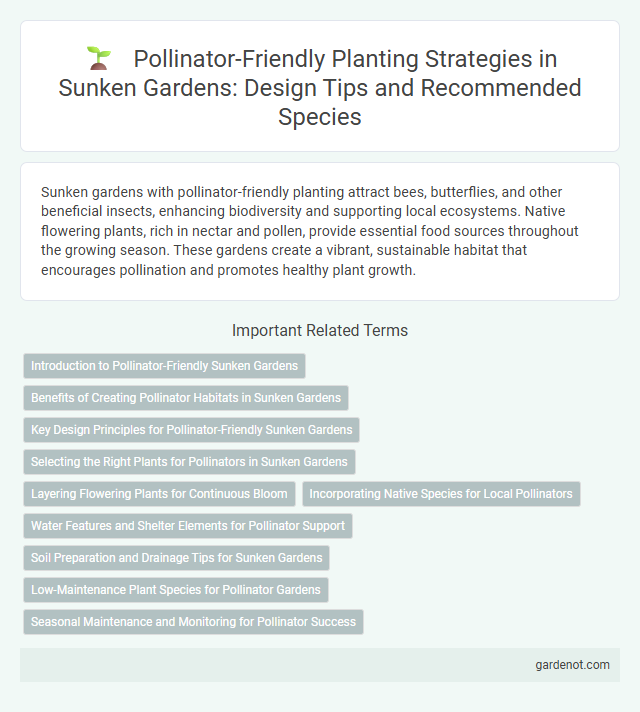Sunken gardens with pollinator-friendly planting attract bees, butterflies, and other beneficial insects, enhancing biodiversity and supporting local ecosystems. Native flowering plants, rich in nectar and pollen, provide essential food sources throughout the growing season. These gardens create a vibrant, sustainable habitat that encourages pollination and promotes healthy plant growth.
Introduction to Pollinator-Friendly Sunken Gardens
Pollinator-friendly sunken gardens create an ideal environment by incorporating diverse native flowering plants that attract bees, butterflies, and hummingbirds. These gardens support essential pollinators by providing nectar-rich blooms and nesting habitats, enhancing biodiversity and ecosystem health in urban or residential spaces. Thoughtful design emphasizes seasonal blooms, ensuring continuous food sources throughout the growing season to sustain pollinator populations year-round.
Benefits of Creating Pollinator Habitats in Sunken Gardens
Sunken gardens rich with pollinator-friendly plants boost biodiversity by providing essential habitats for bees, butterflies, and other pollinators crucial for ecosystem health. These gardens enhance local food production through improved pollination of fruits and vegetables and support environmental resilience against climate change. Incorporating native flowering species in sunken gardens creates sustainable habitats that promote pollinator survival and increase overall garden vitality.
Key Design Principles for Pollinator-Friendly Sunken Gardens
Pollinator-friendly sunken gardens prioritize diverse native plants that bloom sequentially to provide continuous nectar and pollen sources, supporting bees, butterflies, and other vital pollinators. Incorporating varied plant heights and structural diversity enhances habitat complexity, offering shelter and breeding sites for pollinators. Strategic placement of water features and minimizing pesticide use further promote a healthy, sustainable environment in sunken garden designs.
Selecting the Right Plants for Pollinators in Sunken Gardens
Choosing native, nectar-rich plants like milkweed, coneflowers, and bee balm attracts a diverse range of pollinators to sunken gardens. Incorporating a variety of bloom times ensures continuous food sources for bees, butterflies, and hummingbirds throughout the growing season. Prioritizing plants with pollen and nectar that support local pollinator species increases biodiversity and promotes sustainable garden ecosystems.
Layering Flowering Plants for Continuous Bloom
Layering flowering plants in a sunken garden ensures continuous bloom by combining early, mid, and late-season pollinator-friendly species such as lavender, coneflowers, and asters. This strategic planting creates varied bloom times and diverse nectar sources, attracting a wide range of pollinators like bees, butterflies, and hummingbirds throughout the growing season. Incorporating native perennials and annuals enhances resilience and supports local ecosystems by providing consistent habitats and food resources.
Incorporating Native Species for Local Pollinators
Incorporating native plant species in a sunken garden enhances habitat suitability for local pollinators such as bees, butterflies, and hummingbirds by providing nectar and pollen sources adapted to their needs. Native plants foster biodiversity, support ecosystem stability, and improve pollination efficiency within urban and suburban environments. Selecting region-specific flora like milkweed, coneflowers, and goldenrod promotes sustainable pollinator populations and enriches the garden's ecological value.
Water Features and Shelter Elements for Pollinator Support
Water features in sunken gardens provide essential hydration spots that attract bees, butterflies, and other pollinators, enhancing their foraging efficiency. Incorporating shelter elements such as native shrubs, rock piles, and hollow stems offers protective habitats that support pollinator nesting and overwintering. Together, these features create a balanced ecosystem that sustains pollinator populations while promoting biodiversity within the garden environment.
Soil Preparation and Drainage Tips for Sunken Gardens
Soil preparation for sunken gardens focused on pollinator-friendly planting involves enriching the soil with organic matter like compost to improve nutrient content and promote healthy root growth. Ensuring proper drainage by incorporating coarse sand or gravel layers prevents waterlogging, which can harm pollinators' plant roots. Maintaining slightly acidic to neutral soil pH between 6.0 and 7.0 fosters optimal conditions for native flowering plants that attract bees, butterflies, and other essential pollinators.
Low-Maintenance Plant Species for Pollinator Gardens
Low-maintenance plant species such as lavender, catmint, and coneflowers thrive in sunken garden environments, providing essential nectar and pollen sources for bees, butterflies, and other pollinators. Native grasses like little bluestem and switchgrass enhance habitat diversity while requiring minimal care, promoting sustainable pollinator-friendly ecosystems. Incorporating these hardy plants reduces irrigation and fertilization needs, supporting ecological balance and conserving water resources.
Seasonal Maintenance and Monitoring for Pollinator Success
Seasonal maintenance in sunken gardens involves timely pruning, deadheading, and mulching to promote continuous blooming of pollinator-friendly plants, ensuring a steady nectar and pollen supply. Monitoring plant health and pollinator activity through regular inspections helps identify pest issues early and assess habitat effectiveness, allowing for adaptive management. Integrating native flowering species that bloom sequentially supports diverse pollinator populations throughout the growing season, enhancing garden biodiversity and ecological resilience.
Pollinator-friendly planting Infographic

 gardenot.com
gardenot.com